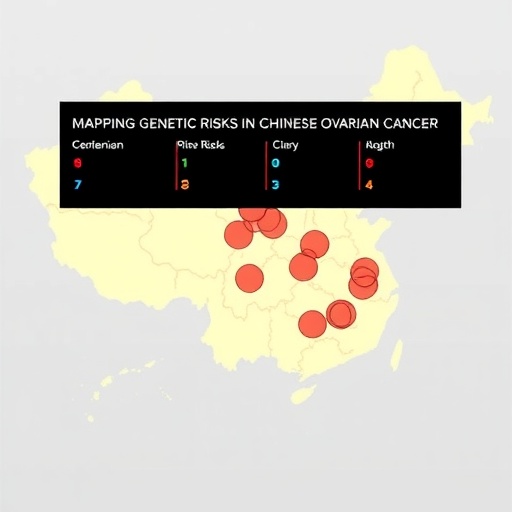In a groundbreaking study published in BMC Cancer, researchers have harnessed the power of whole exome sequencing (WES) to unveil the landscape of germline variations associated with ovarian cancer (OC) in a Chinese cohort. The investigation, involving 92 patients, sheds light on the genetic underpinnings of OC predisposition and underscores the potential for personalized medicine approaches tailored to genetic risk profiles.
Ovarian cancer remains one of the deadliest gynecologic malignancies worldwide, often diagnosed at advanced stages due to subtle symptomatology. While environmental and lifestyle factors contribute to its etiology, hereditary genetic variations play a critical role in an individual’s susceptibility. However, the comprehensive cataloging of such variations in diverse populations, particularly in East Asia, has been limited. This study addresses that gap by applying state-of-the-art next-generation sequencing technology.
Whole exome sequencing enables the analysis of all protein-coding regions of the genome, which harbor the majority of known disease-causing mutations. By focusing on these regions, the researchers could efficiently detect both known and novel germline mutations that may predispose patients to OC. The cohort consisted of patients with or without a family history of cancer, recruited consecutively over three years, providing a well-characterized and representative sample.
Remarkably, the study found that 28.26% of the participants carried pathogenic or likely pathogenic variations in at least one of five key cancer predisposition genes. These genes included BRCA1, BRCA2, RAD51D, BRIP1, and MSH2, all of which have been previously implicated in OC risk but with varying frequencies across different populations. This finding highlights both the conserved and unique aspects of hereditary OC risk within the Chinese population.
The predominance of mutations in BRCA1 and BRCA2 genes, found in 13 and 8 patients respectively, aligns with global data emphasizing their pivotal role in DNA repair and tumor suppression. Mutations in these genes disrupt homologous recombination repair pathways, leading to genomic instability and increased oncogenic potential. However, the identification of pathogenic variants in RAD51D, BRIP1, and MSH2 suggests that other DNA repair mechanisms are also critical contributors.
Beyond these canonical genes, the study uncovered a substantial proportion—26.08%—of patients harboring variants of uncertain significance (VUS). These ambiguous genetic alterations represent a challenging frontier in cancer genomics, as their impact on protein function and clinical relevance remains unclear. Intriguingly, some of these VUS included loss-of-function mutations in genes like RAD54L, RECQL, and NBEAL1, which are not traditionally classified as OC predisposition genes but may represent novel risk factors warranting further investigation.
The detection of loss-of-function variants such as p.Arg609Ter in RAD54L and p.Gln266Ter in RECQL introduces new complexity to the genetic mosaic of OC predisposition. Both genes encode helicase enzymes crucial for maintaining genomic stability, and their dysfunction may undermine the integrity of DNA repair, analogous to the effects observed in BRCA mutations. These insights open avenues for future functional studies and potentially expanded genetic testing panels in clinical settings.
The researchers also noted a significant correlation between the presence of pathogenic variants and patients’ family or personal histories of malignancies. This association reinforces the hereditary nature of these mutations and highlights the importance of detailed family history assessments in cancer risk evaluation and counseling. It also suggests that individuals with such histories may benefit from targeted sequencing approaches like WES to identify at-risk family members.
Importantly, the study demonstrates that whole exome sequencing significantly enhances the detection rate of germline mutations compared to traditional gene panel tests. By expanding the scope beyond well-known predisposition genes, WES uncovers rare and potentially novel variants that may otherwise remain undetected, thus refining risk stratification and guiding precision oncology.
From a clinical perspective, these findings have immediate relevance. Identification of germline mutations in OC patients can inform treatment decisions, such as the use of PARP inhibitors which are particularly effective in tumors harboring homologous recombination deficiencies. Moreover, it supports proactive surveillance and risk-reducing strategies in mutation carriers, potentially improving outcomes through early detection.
The study also lays the groundwork for expanding genetic research into understudied populations, emphasizing the need for global inclusion in genomic databases. The unique mutational spectrum identified in this Chinese cohort illustrates that genetic risk is not monolithic and calls for population-specific guidelines in genetic testing and counseling.
While the functional consequences of many VUS remain to be elucidated, this work underscores the critical role of integrating genomics with clinical data to transform cancer care. Future research endeavors will need to focus on validating these variants, understanding their biochemical impacts, and translating knowledge into actionable interventions.
In summary, this pioneering study exemplifies how cutting-edge genomic technologies can deepen our understanding of cancer biology and open doors for personalized approaches in oncology. By capturing the breadth of germline variation in Chinese ovarian cancer patients, it not only enriches the global knowledge base but also points toward tailored therapeutic and preventive strategies that could save lives.
As the era of precision medicine evolves, the integration of comprehensive sequencing methods such as WES into routine clinical workflows will be fundamental. This study serves as a testament to the power of genomics in unraveling the complex genetic architecture of cancer predisposition, ultimately paving the way for more effective, individualized patient care on a global scale.
Subject of Research: Germline genetic variation and cancer predisposition genes in Chinese ovarian cancer patients analyzed using whole exome sequencing.
Article Title: Identifying the germline variation spectrum and predisposition genes in Chinese ovarian cancer using whole exome sequencing.
Article References:
Guan, X., Liao, S., Zhang, F. et al. Identifying the germline variation spectrum and predisposition genes in Chinese ovarian cancer using whole exome sequencing. BMC Cancer 25, 924 (2025). https://doi.org/10.1186/s12885-025-14302-w
Image Credits: Scienmag.com
DOI: https://doi.org/10.1186/s12885-025-14302-w
Tags: advanced-stage ovarian cancer diagnosiscancer mutation catalogingEast Asian population genetic studiesgenetic predisposition to ovarian cancergenetic risks for ovarian cancergermline variations in Chinese patientsgynecologic malignancies in Chinahereditary factors in ovarian cancernext-generation sequencing technologyovarian cancer etiology and risk factorspersonalized medicine for ovarian cancerwhole exome sequencing in cancer research





